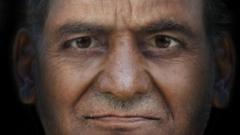Ancient human remains, estimated to be 2,500 years old, have been unearthed during recent archaeological excavations. These significant findings, including a collection of skulls and various accompanying artifacts, were discovered housed within massive burial urns. The site of this notable archaeological breakthrough is situated near Keeladi, located in the southern Indian state of Tamil Nadu. Following their recovery, scientific teams embarked on the complex and meticulous process of reconstructing the faces of these ancient individuals. This sophisticated research endeavor involved the application of advanced techniques to bring to life the visages of people who lived millennia ago, offering a unique glimpse into their appearance and the historical context of the region. The methodologies employed in digitally or physically recreating these ancestral faces represent a cutting-edge intersection of archaeological science and forensic anthropology, contributing valuable insights to our understanding of past populations.
POPULAR CATEGORY
© Newspaper WordPress Theme by TagDiv



